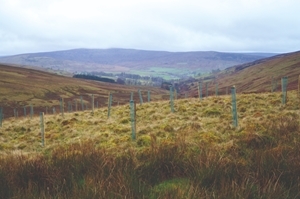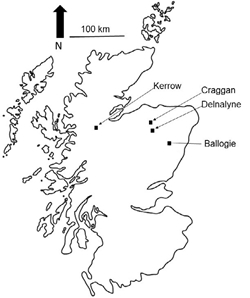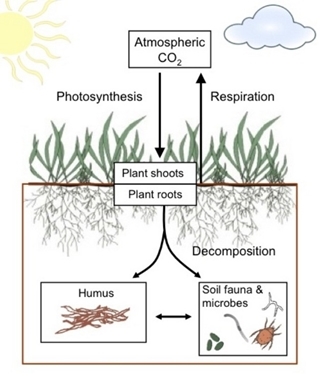Key points
- Tree planting is proposed as a method to combat climate change.
- Carbon sequestration is the process of taking carbon from the atmosphere and incorporating it into the tree’s biomass or soil.
- Three native species of trees, two birch and one pine, were planted onto heather moorland at four sites in Scotland to calculate the change they cause in carbon levels.
- Tree planting did not lead to an increase in carbon within the ecosystem over 12-39 years after planting. There was even a loss of carbon at one site.
- Tree planting caused greater soil respiration and lower levels of carbon in the soil, when compared to pre-existing heather ground cover that was unchanged and not burnt.
- The loss of soil carbon cancels out the increase in the tree’s biomass carbon over decades.
- This is relevant to current policies, which promote tree planting to ease climate change.
- The change in carbon levels needs to be better understood and quantified so the impact that large-scale tree planting has on existing soil carbon levels can be measured and the intended outcome can be achieved.
Background
 The human impact on the environment is the biggest threat to natural and managed ecosystems. There are multiple worldwide strategies proposed to help reduce climate change, including afforestation. Afforestation is establishing a forest in an area where there was no previous tree cover. Trees are planted to take in carbon from atmospheric carbon dioxide (CO2) into the biomass of the tree. Removing carbon to slow or reverse CO2 pollution is known as carbon sequestration. CO2 is taken from the atmosphere through biological, chemical and physical processes. Changing land use from crops and grazing livestock to fast-growing plants can accelerate this. The carbon taken in by afforestation, although stored for a long time but not indefinitely, should not return to the atmosphere via burning or rotting.
The human impact on the environment is the biggest threat to natural and managed ecosystems. There are multiple worldwide strategies proposed to help reduce climate change, including afforestation. Afforestation is establishing a forest in an area where there was no previous tree cover. Trees are planted to take in carbon from atmospheric carbon dioxide (CO2) into the biomass of the tree. Removing carbon to slow or reverse CO2 pollution is known as carbon sequestration. CO2 is taken from the atmosphere through biological, chemical and physical processes. Changing land use from crops and grazing livestock to fast-growing plants can accelerate this. The carbon taken in by afforestation, although stored for a long time but not indefinitely, should not return to the atmosphere via burning or rotting.
There is more carbon stored in soil globally than in plants and the atmosphere combined. How much carbon is stored in soils depends on land use, vegetation cover and the climate. Higher carbon levels are found in low stature, non-woody vegetation rather than within forests. Planting trees in unforested areas changes plant and below-ground communities, reshaping the ecosystem by interacting with carbon within the soil and even releasing carbon back into the atmosphere. To read more about the input and output of carbon in soil, please see the box below. Both above- and below-ground organisms are important for carbon sequestration and it is vital to understand how they respond to climate warming. Changing the land use and plants present can affect the biological processes, but the consequences of all these changes is relatively unknown.
Afforestation can have a positive effect on carbon sequestration by taking the carbon from the atmosphere and adding to the tree’s biomass. The effect this has on the carbon within the soil depends on the type of tree, forest management, land use before afforestation and the characteristics of the soil. Another important consideration is the fungi in the soil and the mutual relationship it has with plant and roots.
The scientists aim to identify the impact of tree planting on sites with organic rich soils. It is important to understand the consequences of afforestation for the whole ecosystem carbon stocks, both above and below ground.
What they did
 Four experiment sites across northern Scotland were used, these are shown in Figure 1.
Four experiment sites across northern Scotland were used, these are shown in Figure 1.
Three different native tree species, downy birch, silver birch or scots pine, were planted onto heather-dominated moorlands with adjacent unplanted control plots. Plots for tree planting and heather control treatments were randomly assigned based on previous soil measurements. The heather plots used were the original moorland vegetation that was unchanged and, most importantly, not burned.
Within these plots, different measurements were taken to examine the impact these trees have on carbon levels. First, soil respiration was measured. This refers to the carbon dioxide that soil organisms produce after taking in carbon from the atmosphere. These organisms include roots, microorganisms and fauna. For more information on soil respiration, please see the box below. Soil respiration is measured using an infrared gas analyser, taking samples from all four sides of the plot, both on the edge and inside.
To measure the amount of carbon stored in the tree (carbon stocks), the size, height and girth, are measured. At the Ballogie site, above-ground biomass from shrubs, flowering plants (forbs) and grasses was converted into carbon stock by destructive harvesting and drying samples. At the three other sites, above and below carbon stocks were not measured and assumed to be the same as Ballogie due to similar vegetation cover. In heather control plots at Ballogie, root carbon stocks were measured by plucking, washing and drying, converting this weight to carbon stocks.
What they found
| Additional release of carbon from soil |
|
Organic matter within soil contains of a variety of microorganisms (bacteria and fungi) but also decaying material from other organisms, including plants, animals and faecal material. This organic matter is rich in carbon, known as soil organic carbon (SOC).
The SOC levels are linked with the ecosystem, and the processes of photosynthesis, respiration and decomposition affect these levels. Photosynthesis is a chemical reaction taking place inside plants, converting carbon dioxide, light and water into biomass - the weight of the plant. Root biomass and any leaf debris produced by the plant shoots contribute to SOC.
Many plants have a relationship between their roots and the fungi found within the soil, known as mycorrhizae. This is where roots provide carbon as energy for fungi and they provide nutrients for the root. Carbon can be lost as carbon dioxide when the soil microbes start to decompose the biomass, causing microbial respiration.
Meanwhile, a small amount of organic carbon remains in the soil, the SOC. If the carbon input is the same as the amount lost through respiration and decomposition, then there will be no change in the SOC level. However, if there is more input from photosynthesis, SOC will increase. If there is a higher loss of carbon, either through these ecosystem processes or other methods such as soil erosion or removing carbon via the ground water, then the SOC levels will decrease over time. This process can be explained in figure 2. These processes are affected by the climate, soil temperature, soil makeup and moisture levels.
 Figure 2: The affect photosynthesis, respiration and decomposition have on carbon levels below ground. Decomposition of roots, microbes and fauna cause respiration of carbon, with some remaining as humus, the soil organic carbon (SOC). This image is from Nature Education, © 2012. Figure 2: The affect photosynthesis, respiration and decomposition have on carbon levels below ground. Decomposition of roots, microbes and fauna cause respiration of carbon, with some remaining as humus, the soil organic carbon (SOC). This image is from Nature Education, © 2012.
|
12 years after planting, in Ballogie, there was 58% less carbon in the soil stocks of birch trees compared to unplanted heather control plots. The combined above- and below-ground carbon in these birch plots was lower than the total carbon in heather plots. During these 12 years, there was significantly higher soil respiration in the birch and pine plots, compared to heather.
At Kerrow, carbon levels within the soil of the birch plots was 50% less compared to unplanted heather control. After 39 years, the amount of carbon contained within the ecosystem was not significantly different between birch plots and heather controls.
At the Craggan and Delnayne sites, there was no difference between the birch and heather plot’s soil carbon or the carbon stock within the ecosystem.
When examining differences between the trees and heather control plots, across one growing season, there was a noticeable seasonal difference between May and September. There was no difference between the number of roots in heather plots, compared to birch and pine, or mycorrhizal hyphae (how nutrients are taken in) produced.
None of the weeding treatments used were associated with the altered soil respiration, when compared to unweeded controls in heather.
What does this mean?
Any differences in the amount of carbon stored in the soil between the trees and unplanted heather control plots was caused by tree planting. Despite an increase in above-ground carbon related to tree biomass and growth, there was a loss of carbon in the soil. Therefore, there was no increase in the overall ecosystem’s carbon stock at any site during the experiment and even a loss at one site. The combined above- and below-ground carbon stocks of pine plots was similar to the heather plots over 12 years, leading to little change in the amount of carbon taken from the atmosphere in the short to medium term. It is important to remember that the heather moorland controls used in this study were never burned, and the absence of burning is likely to have contributed to the large carbon stores found in the heather plots.
At the Kerrow site, the amount of above-ground carbon gained from trees over 39 years was enough to offset the initial significant loss of carbon within the soil, caused by tree planting. As birch continues to grow over time, this may lead to carbon sequestration, but only if there is no further loss through the soil. However, there is no evidence of a significant increase in the overall amount of carbon in the ecosystem in the tree plots of the sites used.
Over the course of 12 years, planting native trees species onto heather moorlands resulted in a greater release of CO2 from the soil. The above-ground inputs stimulate the soil microorganisms to decompose the carbon in the soil, releasing it as CO2.
There were significant differences in soil carbon between each of the sites examined. This difference is due to the unique conditions of each site, including the non-living chemical and physical parts of the environment that can affect the ecosystem and organisms. Furthermore, moisture levels, landscape and pre-existing soil conditions can impact the soil carbon stores. Therefore, there needs to be careful consideration when choosing sites for the future tree-planting schemes.
The current policy to not permit afforestation on peat that is more than 50cm deep should be reviewed and tightened. There needs to be a refined approach to evaluating carbon stocks within the soil before considering planting trees. There have been recommendations to the Scottish Government’s Woodland Expansion Advisory Group that 34% of Scotland’s land area may have potential for woodland expansion. However, this will risk jeopardising the soil and ecosystem carbon stocks on heather moorlands and heathlands. As interest grows in afforestation, there needs to be better understanding of carbon fluctuations before there is any large-scale tree planting in areas with soil organic carbon. This is important to make sure the intended climate outcomes are met.
Author’s note
The authors of the paper would like it known this research is not an endorsement of heather burning as an alternative to tree planting. The focus of this research was to examine the impact tree planting had on removing carbon from the atmosphere and used heather in order to have a comparison. It is important to remember that the heather moorland controls used in the research were never burned, and not burning them is likely to have contributed to the larger carbon stores found in these heather plots.
Read the original paper
Friggens, N.L., Hester, A.J., Mitchell, R.J., Parker, T.C., Subke, J.A. & Wookey, P.A. (2020). Tree planting in organic soils does not result in net carbon sequestration on decadal timescales. Global Change Biology, 1–11.